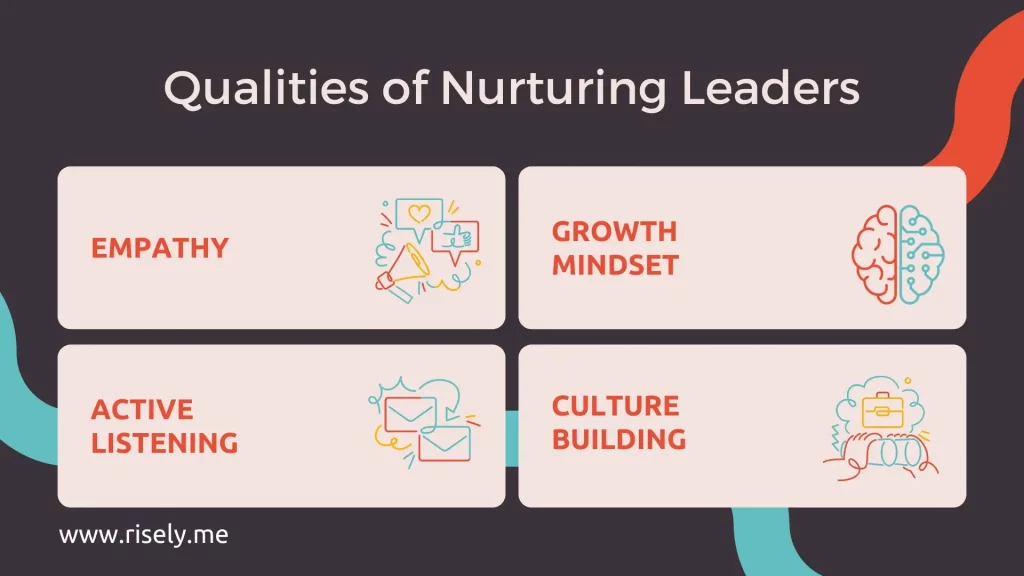6 Habits Of Nurturing Leaders That Teams Love
What’s your definition of leadership? For ages, we focused on assigning tasks and reviewing things. But today’s leaders are doing much more than that – setting performance expectations, building cultures, and guiding career growth for their team members – essentially becoming nurturers more than mere managers. Positive leaders inspire their teams, infusing a sense of purpose and motivation. They create a supportive atmosphere that encourages employees to stay, reducing turnover and associated costs and prioritizing their well-being. They understand the importance of work-life balance, mental health, and job satisfaction, showing their team members that they are valued and cared for. In this blog, we will decode the making of nurturing leaders, defining their essential characteristics and methods that you can adopt to nurture your team as a leader.What is Nurturing Leadership?
Nurturing leadership is about genuinely caring for their team members and prioritizing their growth and well-being. It involves adopting a leadership style that goes beyond traditional management and creates a positive work environment. Nurturing leaders invest in leadership development programs and mentorship to hone their skills. They lead with authenticity, empathy, and a clear vision for the future. They demonstrate resilience and adaptability in the face of challenges and empower their team members to take ownership of their work. This approach fosters an inclusive culture, promotes continuous learning, and encourages open communication and constructive feedback. Read more: Why Do Managers Need Guidance Ability To Become Effective Leaders?What does a nurturing leader look like?

- Empathy: to understand your own and your team’s emotions well
- Active listening: to understand the needs and feelings of your team
- Culture building: fostering a safe space where inclusivity and authenticity thrive
- Growth mindset: to overcome setbacks and reframe them into learning opportunities
How Nurturing Leaders Differ from Traditional Managers?
Nurturing leaders differ from traditional managers in several ways. Firstly, their leadership style focuses on developing their team members’ potential rather than just managing tasks. While conventional managers may prioritize achieving goals and meeting deadlines, nurturing leaders prioritize the growth and well-being of their team members. Another difference lies in the approach to communication. Nurturing leaders foster open and transparent communication within their teams. They encourage feedback, ideas, and discussions, creating an environment where team members feel comfortable expressing their thoughts and concerns. In contrast, traditional managers may have a more top-down communication style, leading to limited input from team members. Constructive feedback is another area where nurturing leaders shine. They provide feedback focused on growth and improvement rather than criticism. Nurturing leaders understand the value of constructive feedback in helping team members develop their skills and reach their full potential. Traditional managers, on the other hand, may focus more on pointing out mistakes rather than offering constructive guidance. Overall, nurturing leaders prioritize the growth and well-being of their team members, foster open communication, and provide constructive feedback to drive individual and team success.Other Interesting Reads
What habits of nurturing leaders do teams love?
The habits of nurturing leaders shared below sum up their actions and attitudes. Pick up these traits like a cheat sheet and you will be the best guide your team ever had:Habit 1: Empathy and Active Listening
One of the critical habits of nurturing leaders is practicing empathy and active listening. Empathy allows leaders to understand the needs and feelings of their team members, fostering a sense of connection and trust. By understanding and acknowledging the emotions and experiences of team members, you can create a culture of genuine care and support. Active listening involves:- Fully engaging with team members.
- Paying attention to their words.
- Seeking to understand their perspectives.
Habit 2: Encouraging Professional Growth
Encouraging professional growth is another habit of nurturing leaders. They understand the importance of continuous learning and career development for their team members. Supporting career development is an essential strategy for nurturing leaders. There are many ways you can do this for your team:- Offer training, workshops, and coaching to develop leadership skills and empower team members to take on leadership roles.
- Pair team members with experienced employees as mentors to provide guidance, support, and advice.
- Delegate responsibilities and provide autonomy, allowing team members to take ownership of their work and grow in their roles.
- Promote a learning culture and provide resources and opportunities for team members to expand their skills and knowledge.
- Identify and provide opportunities for team members to take on new challenges, projects, or roles that align with their career goals.
Habit 3: Fostering a Positive Work Environment
Fostering a positive work environment is a critical habit of nurturing leaders. They understand the impact of the work environment on team dynamics and overall performance. Creating a positive work environment promotes collaboration, motivation, and well-being among your team members. Nurturing leaders prioritize building solid relationships, encouraging open communication, and recognizing achievements. A positive work environment enhances team morale, increases productivity, and fosters innovation.What builds a positive workplace environment?
Building a supportive workplace culture is essential for nurturing leaders. Here are some practical steps to create a supportive workplace culture:- Foster open communication: Encourage open and transparent communication among team members and between the leadership team and employees.
- Lead by example: Your words set the tone for a supportive culture. Use them to demonstrate positive behaviors and attitudes in your interactions with team members.
- Recognize and celebrate accomplishments: Regularly recognize and celebrate the achievements and contributions of your team members to reinforce a positive work environment.
- Empower employees: Delegate responsibilities and provide autonomy, allowing your team to take ownership of their work and make decisions.
- Promote diversity and inclusion: Create a culture that values and embraces diversity, ensuring all your employees feel included and respected.
Habit 4: Promoting Work-Life Balance
Promoting work-life balance is a crucial habit of nurturing leaders. They understand the importance of allowing their team members to have a healthy balance between work and personal life. By prioritizing work-life balance, you can create an environment that promotes well-being, job satisfaction, and happiness. Nurturing leaders support flexible work arrangements, provide resources for self-care, and encourage open communication about workloads and personal commitments. By promoting work-life balance, you can ensure that your team members have the energy and motivation to excel at work and in their personal lives.Habit 5: Transparent Communication
Transparent communication is a fundamental habit of nurturing leaders. They understand the importance of open and honest communication in fostering trust and creating a supportive work environment. By being transparent in your communication, you build trust among your team members and encourage open dialogue. Nurturing leaders share information openly, communicate expectations clearly, and ensure team members have the resources and support to succeed. By prioritizing transparent communication, you create a culture of trust, collaboration, and accountability – all of which are critical values for success.Here are some ways nurturing leaders can build trust through openness and honesty:
- Share information: Be transparent in sharing relevant information with team members, informing them about goals, decisions, and changes.
- Communicate expectations: Clearly communicate expectations and provide regular updates on progress, ensuring that your team members understand their roles and responsibilities.
- Be honest and authentic: Demonstrate honesty and authenticity in your interactions with team members, building credibility and trust.
- Admit and take responsibility: When mistakes happen, be open about them, take responsibility, and work towards solutions. This fosters trust and shows that you are accountable.
- Encourage feedback and voice concerns: Create a safe space for team members to share their feedback, concerns, and ideas. Actively listen and address their concerns, building trust and demonstrating that their opinions are valued.
Habit 6: Leading by Example
Leading by example is a critical habit of nurturing leaders. They understand that their actions speak louder than words and strive to be positive role models for their team members. By modeling the behavior and attributes you expect from your team, you can inspire and motivate team members to follow suit. Nurturing leaders demonstrate integrity, authenticity, and accountability in their actions and decisions, earning the respect and admiration of their team. By leading by example, you can similarly create a culture of excellence and inspire your team members to perform at their best.The Impact of Leader Behavior on Team Morale
Leader behavior significantly impacts team morale, and nurturing leaders understand this. Here are four primary impacts that you should consider while nurturing your team as a leader:- Inspiration: Nurturing leaders inspire their team members through their upbeat attitude, resilience, and commitment to excellence. This encourages team members to perform at their best and boosts team morale.
- Trust and respect: By demonstrating integrity, authenticity, and accountability, nurturing leaders earn the trust and respect of their team members. It creates a positive work environment and enhances team morale.
- Collaboration and teamwork: Nurturing leaders foster a culture of collaboration and teamwork through their behavior and actions. This promotes a sense of belonging and camaraderie, boosting team morale.
- Recognition and appreciation: Nurturing leaders recognize and appreciate the efforts of their team members, reinforcing a positive work environment and boosting team morale.
Wrapping Up
In conclusion, nurturing leadership is the cornerstone of building strong, cohesive teams. By embodying traits like empathy, encouragement of professional growth, fostering positivity, promoting work-life balance, transparent communication, and leading by example, nurturing leaders create environments where team members feel valued and supported. These leaders prioritize not just the organization’s success but also their team members’ well-being and development. By embracing these habits, you can cultivate trust, loyalty, and high performance within your teams, ultimately leading to a thriving and engaged workforce.Guidance works best with good feedback.
Are your skills strong enough?
Master the art of constructive feedback by reviewing your skills with a free assessment now.
Other Related Blogs
Top 10 Executive Coaching Books For Great Managers
Top 10 Executive Coaching Books For Great Managers A great leader is not just someone who can manage tasks and projects, but also someone who can coach and develop their team members to…
Manager Effectiveness: A Complete Guide for Managers in 2024
Manager Effectiveness: A Complete Guide for Managers in 2024 Manager effectiveness is everyone’s favorite buzzword. But the road to achieving it is trickier than it looks like! While manager effectiveness…
5 Primary Coaching Skills for Managers and How to Develop Them
5 Primary Coaching Skills for Managers and How to Develop Them Picture this: you’ve landed that coveted manager title, team brimming with potential at your fingertips. Now comes the real…
How To Be A Role Model At Work? 6 Tips For Managers
How To Be A Role Model At Work? 6 Tips For Managers If an organization is to run smoothly and sustainably, people need to be at the right place for…


